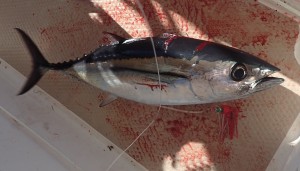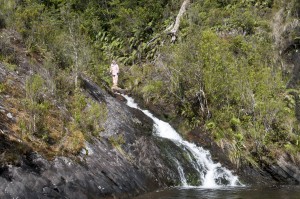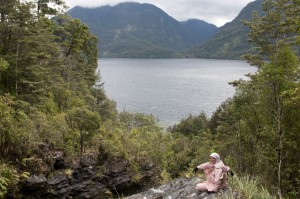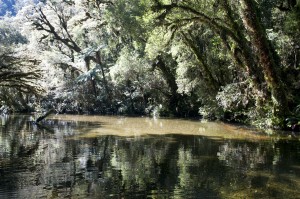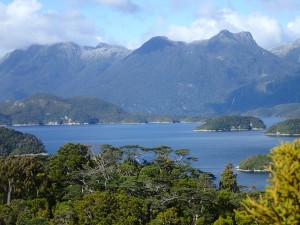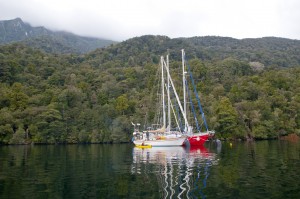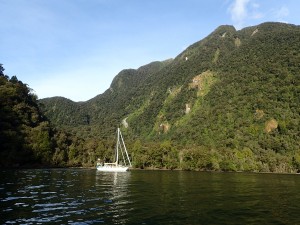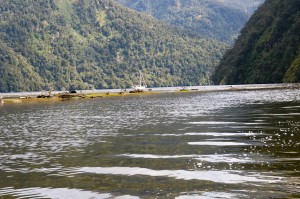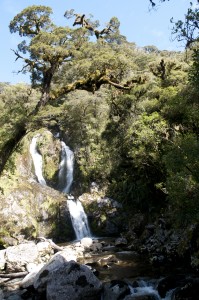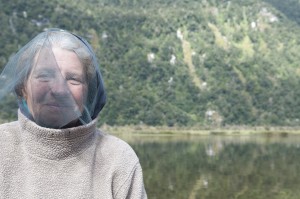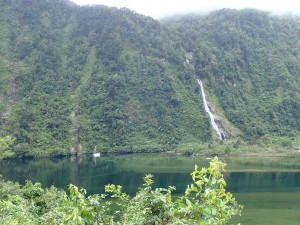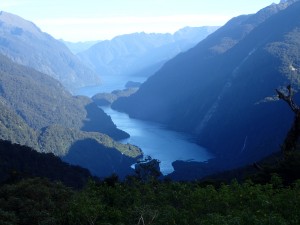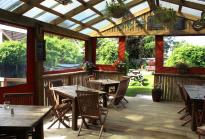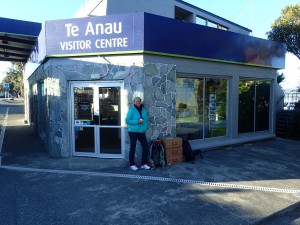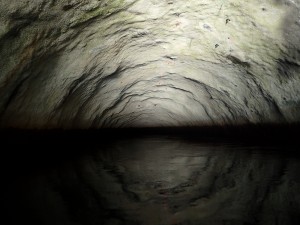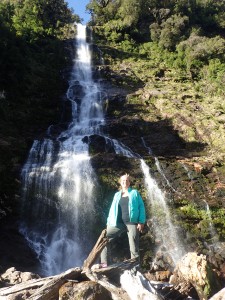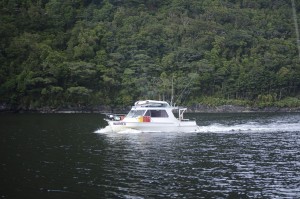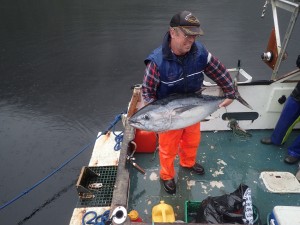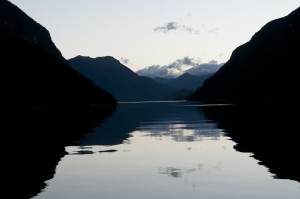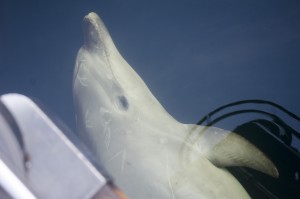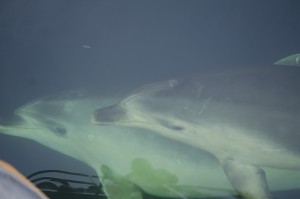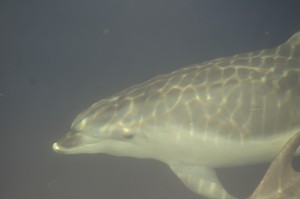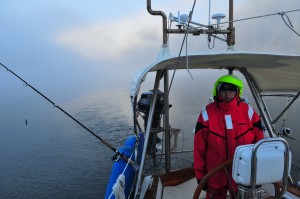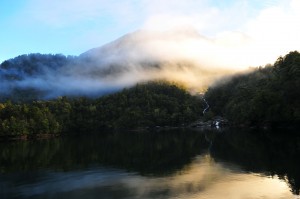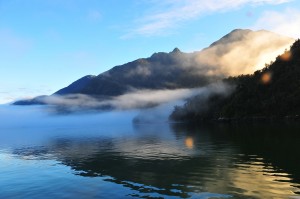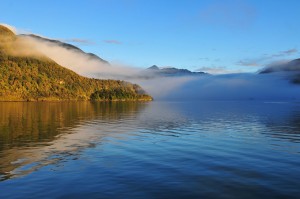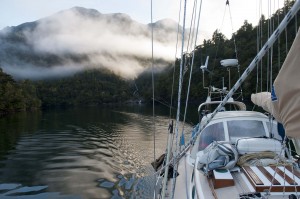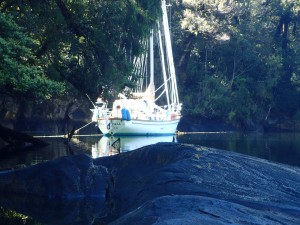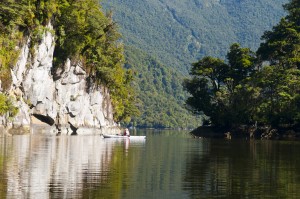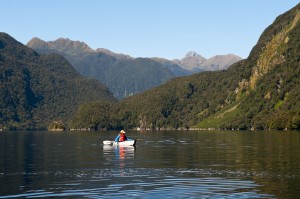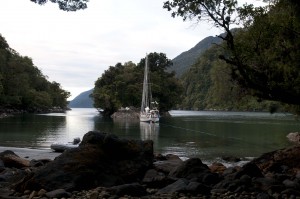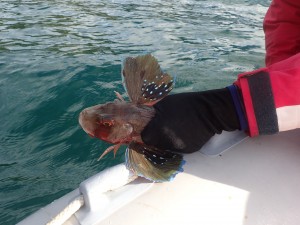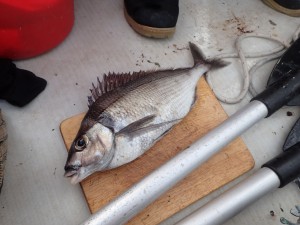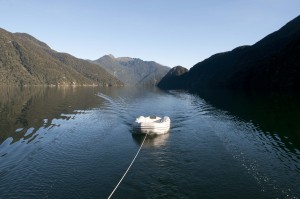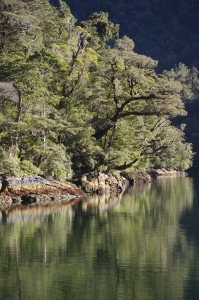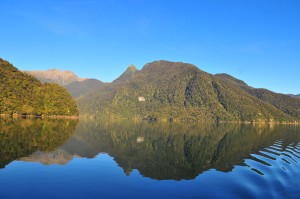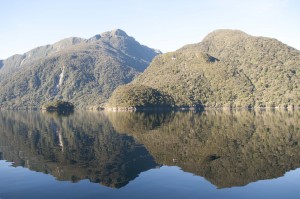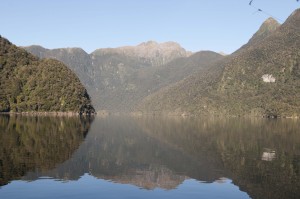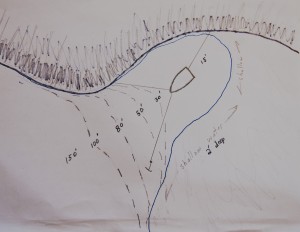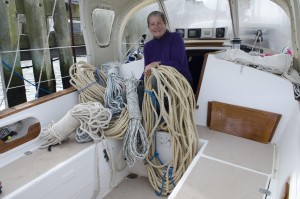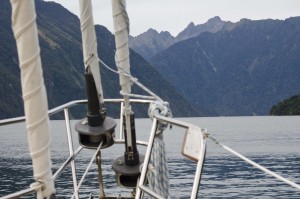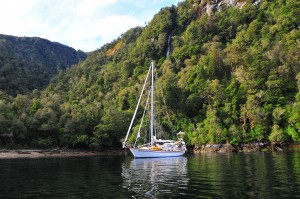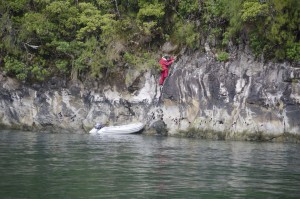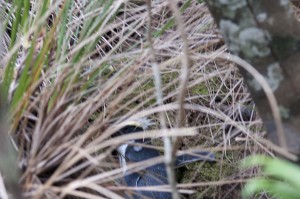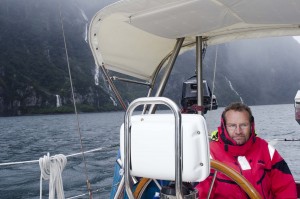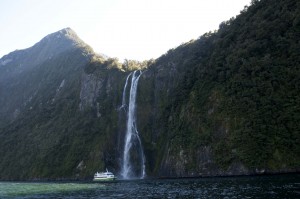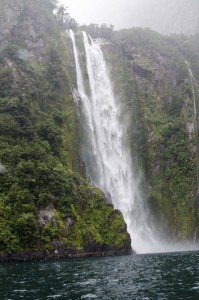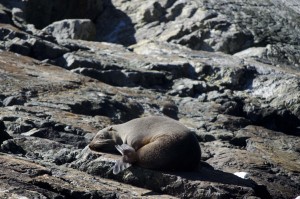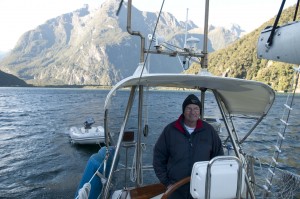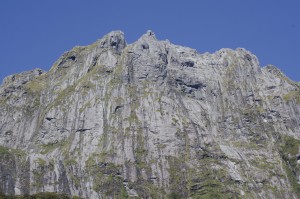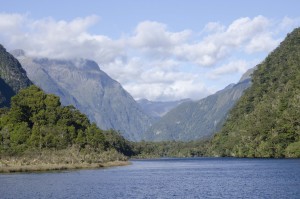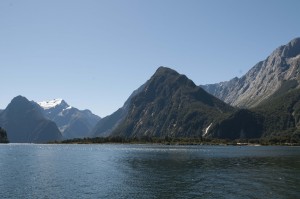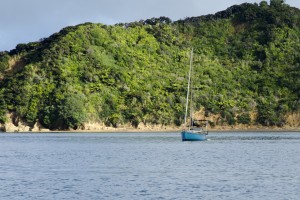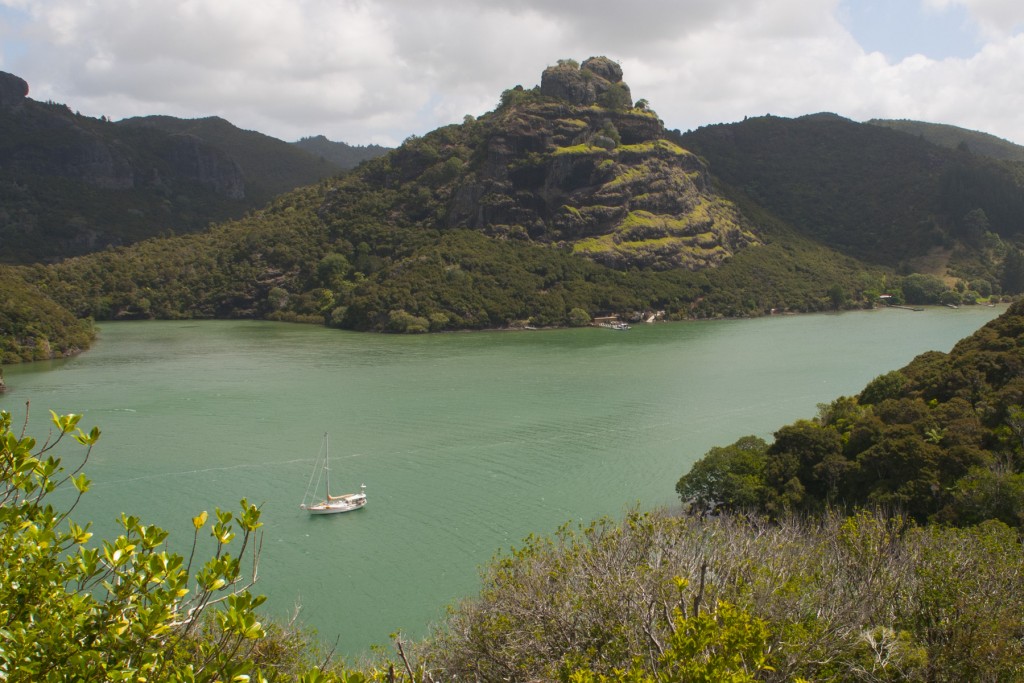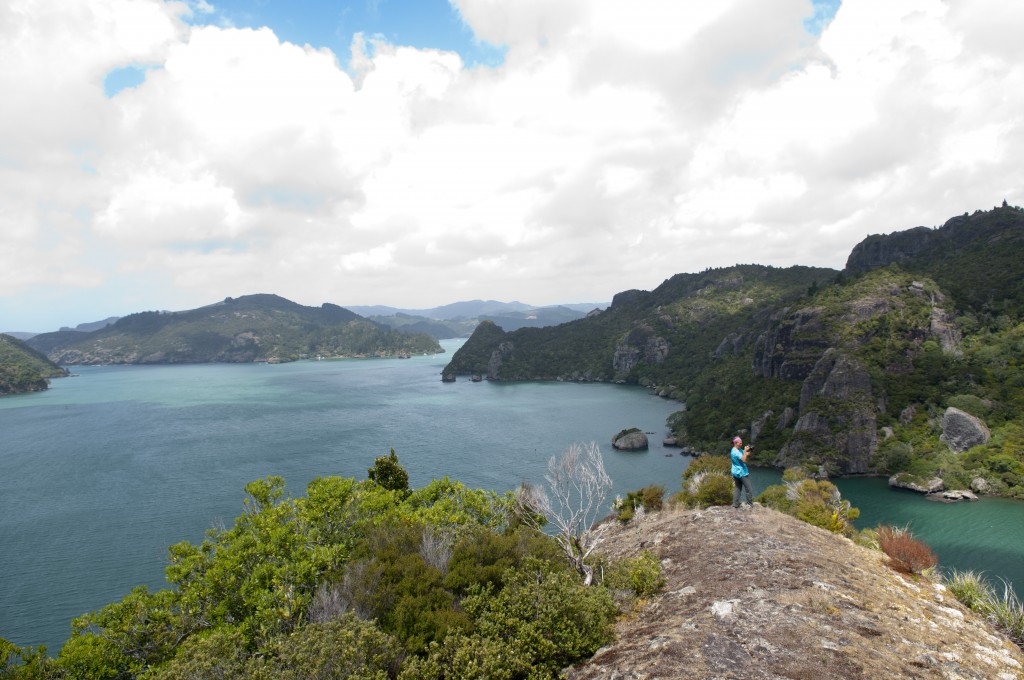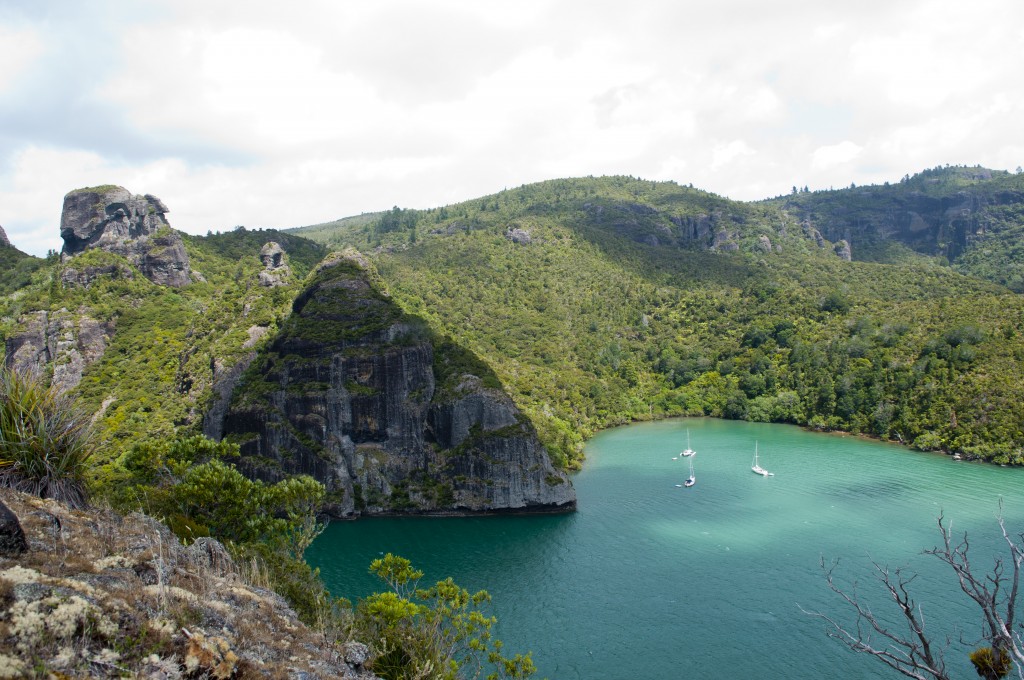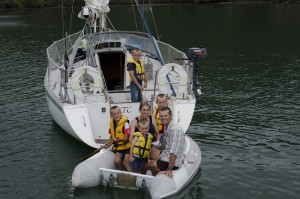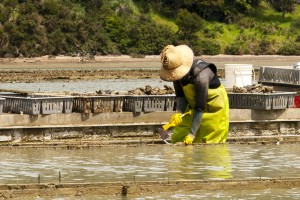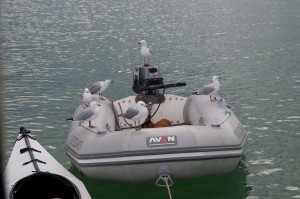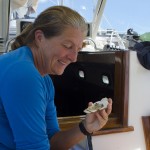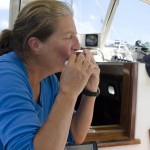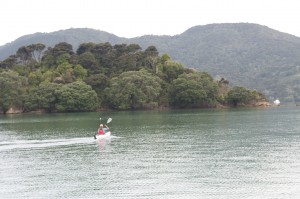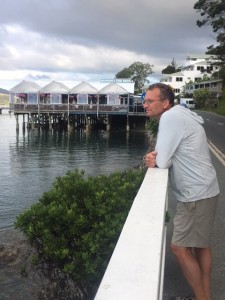Post by Barb
It turned out that the Fiordland peanuts was a bowlful of Crayfish legs. A night of crayfish legs and tuna sushi was special.
When we left Doubtful sound it was forecasted to be a motor day but we had 20-25 knots on the rear quarter as it funneled through the fiords so we had a beautiful sail out. Once we were back in open waters the wind died down but the swell was still bad so it was a seasick day for me. But the good news was that we caught a Blue Fin Tuna, about a third of Billy’s Tuna so that was exciting. Denny had to reel it in and clean it while I tried to hold my breakfast. We ended up motor sailing to Dusky with the wind on the nose.
Click here for Google Map Link – Stick Cove
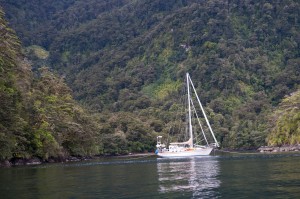 Our first anchorage was Stick Cove on the corner of Acheron passage and Wet Jacket Arm. It was a little cove well sheltered by an Island and it required shorelines but by this time we were getting pretty efficient with the typical anchoring process. Did I say I wasn’t going to mention sandflies anymore? Well this place was now our new worst sand-fly haven. But on the first night there we feasted on Tuna sushi and leftover crayfish again so we couldn’t complain too much. We spent 2 nights in Stick Cove and because of the sandflies we just did a dinghy tour down Wet Jacket Arm which was a marine reserve, although the only evidence of marine life were seals.
Our first anchorage was Stick Cove on the corner of Acheron passage and Wet Jacket Arm. It was a little cove well sheltered by an Island and it required shorelines but by this time we were getting pretty efficient with the typical anchoring process. Did I say I wasn’t going to mention sandflies anymore? Well this place was now our new worst sand-fly haven. But on the first night there we feasted on Tuna sushi and leftover crayfish again so we couldn’t complain too much. We spent 2 nights in Stick Cove and because of the sandflies we just did a dinghy tour down Wet Jacket Arm which was a marine reserve, although the only evidence of marine life were seals. 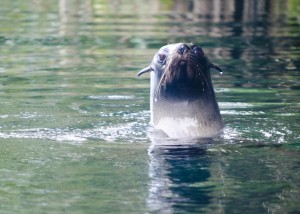 We did another waterfall hike but ended up punching a small hole in the dinghy while trying to access the shore. We realized how little problems could escalate into an emergency as we faced a long dinghy trip against an escalating wind on the nose. Paddling back to the boat if the outboard failed would be a monumental task. But we made it back safely and had another wonderful evening with another Tuna sushi and fried Blue Cod on the menu.
We did another waterfall hike but ended up punching a small hole in the dinghy while trying to access the shore. We realized how little problems could escalate into an emergency as we faced a long dinghy trip against an escalating wind on the nose. Paddling back to the boat if the outboard failed would be a monumental task. But we made it back safely and had another wonderful evening with another Tuna sushi and fried Blue Cod on the menu.
Click here for Google Map link – Supper Cove
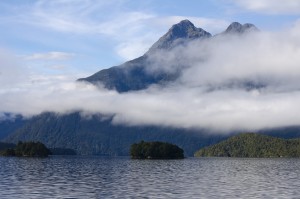 We left the sandflies behind and did a scenic motor tour to the end of Dusky Sound. There
We left the sandflies behind and did a scenic motor tour to the end of Dusky Sound. There 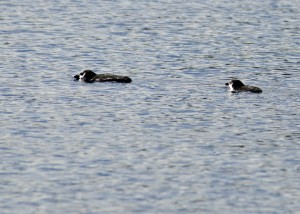 were penguins and seals everywhere and the sunshine allowed us to sit outside in the cockpit without the pesky sandflies. Supper Cove is located at the very end of Dusky Cove and there we found a large mooring that we could tie to.
were penguins and seals everywhere and the sunshine allowed us to sit outside in the cockpit without the pesky sandflies. Supper Cove is located at the very end of Dusky Cove and there we found a large mooring that we could tie to.
The Seaforth River nearby provided some great Kayaking opportunities giving us a different view of NZ temperate rainforest. On shore, there was a Department of Conservation hut, which was part of the Dusky Track. The 84-km track is often flaunted as being one of NZ hardest trails forcing its way through some impressive rain resistant landscapes. We walked part of the track, following the little orange triangles, sometimes sinking in inches of squelchy mud, imagining what it would be like to do the full 84 kilometers with a heavy pack on. The surrounding greenery of the temperate forest brought back memories of the Lord of the Rings trilogy and why it was the ideal, natural backdrop. Sometimes I even imagined Gollum sneaking around behind us. There were a couple of European boys from Hungary, Poland Germany and Czechoslovakia staying at the hut and they spent countless hours on the shore trying to catch some fish. They were probably tired of the eating the dried backpacking food. It turns out that Supper Cove was the major helicopter hub for dropping off tourists doing the weekly Dusky Sound boat tours. The tours catered to mostly to people interested in diving for Crayfish or hunting for deer. 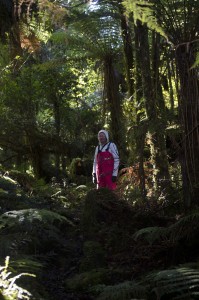
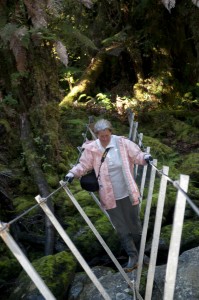
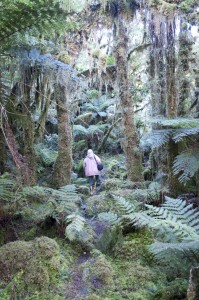
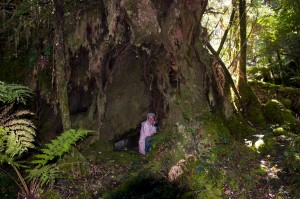
Click here for Google Map link – Luncheon Cove
When we left Supper Cove we decided to take a different route through the Cook channel. It was a much narrower channel and parts of it unsurveyed so I stood on the bow looking for unchartered rocks or shallows. By the time I spotted the large shoal it was too late. I yelled to Denny to make a hard turn Starboard or full throttle reverse but the current was taking us unto the shoal no matter what we tried. We hit but managed to scrape off and we hit once more while trying to get out of there. We did manage to get back on track safely but we now have Fiordland battle scars to deal with when we get back to Dockland 5. As we got closer to Luncheon Cove the wind was slowly building and it started to rain as well. I was still feeling a little shell shocked from our last bottom hit. The passage to Luncheon got narrower and at one point we had to navigate through a very narrow opening with waves crashing on both sides while the wind was averaging 30 knots on the nose. 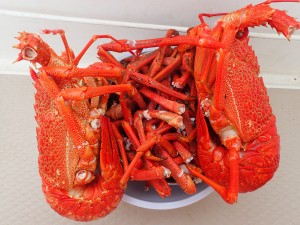 The depth sounder suddenly went from 200 to 20 feet and I was in a knot of fear. Denny seemed calm enough and got us through unscathed. Luncheon Cove was well hidden and we had to navigate around a little opening to enter a protected cove. There was a power boat, Dellamekyl, already there but they invited us to raft up to them and we joined them for a couple of drinks and a fine beef stew meal. We traded a bottle of red wine for a couple of crayfish and as Captain Cook did many many years ago in Luncheon Cove, we also ‘dined on cray-fish’ there.
The depth sounder suddenly went from 200 to 20 feet and I was in a knot of fear. Denny seemed calm enough and got us through unscathed. Luncheon Cove was well hidden and we had to navigate around a little opening to enter a protected cove. There was a power boat, Dellamekyl, already there but they invited us to raft up to them and we joined them for a couple of drinks and a fine beef stew meal. We traded a bottle of red wine for a couple of crayfish and as Captain Cook did many many years ago in Luncheon Cove, we also ‘dined on cray-fish’ there.
Luncheon Cove was our favorite anchorage in Dusky and although it was touted as being an all-weather anchorage we did experience a rough night with a 50 knot northerly gale. This cove has quite a historical significance as it was used as a sealing base in the late 1700’s, it was the site of the first European settlement in NZ and the building site of NZ first European-style vessel. 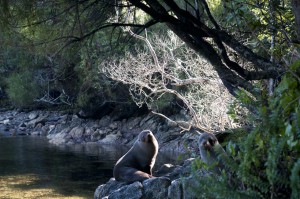
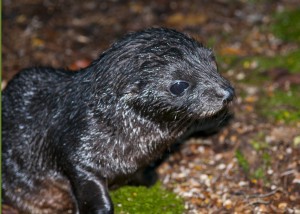 Seals were plentiful here and we could hear them grunting and roaring any time of day while the babies played around in the cove. We woke up one morning to a different sound than the roaring seals and it turned out to be the screeching of a terrified Grey Heron that was being chased by a hawk.
Seals were plentiful here and we could hear them grunting and roaring any time of day while the babies played around in the cove. We woke up one morning to a different sound than the roaring seals and it turned out to be the screeching of a terrified Grey Heron that was being chased by a hawk. 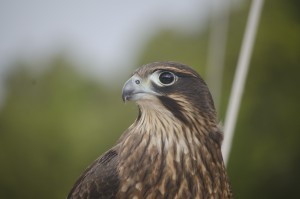 The hawk would not let the heron land anywhere except on our boat. Sitting on our lifeline was the only reprieve the Heron had.
The hawk would not let the heron land anywhere except on our boat. Sitting on our lifeline was the only reprieve the Heron had. 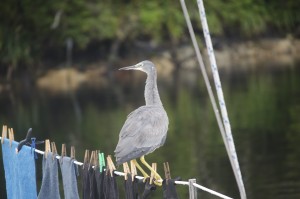 We have often tried to get close to the Herons to get a good picture but never could and now we had one sitting a few feet away from us. Each time the Heron attempted to escape the hawk would go after it. This predator and prey scene continued for quite some time until the Heron landed on a rock outcrop. The hawk made a dive for the heron but was scared away by a seal that was playfully splashing near the heron. I guess the hawk didn’t like the idea of suddenly becoming the prey.
We have often tried to get close to the Herons to get a good picture but never could and now we had one sitting a few feet away from us. Each time the Heron attempted to escape the hawk would go after it. This predator and prey scene continued for quite some time until the Heron landed on a rock outcrop. The hawk made a dive for the heron but was scared away by a seal that was playfully splashing near the heron. I guess the hawk didn’t like the idea of suddenly becoming the prey.
We did a few tracks on the nearby shores and were followed by lots of curious birds. 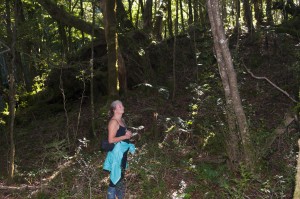
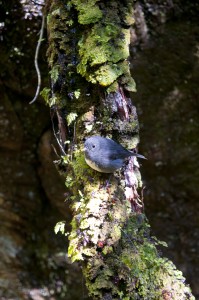
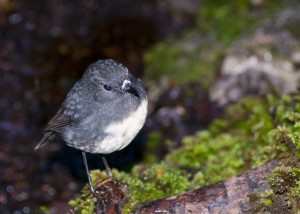
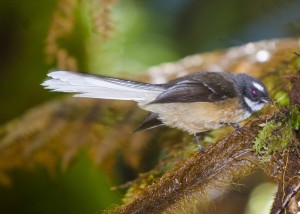
We also made a couple of dinghy trips to catch our daily quota of Blue Cod for dinner. 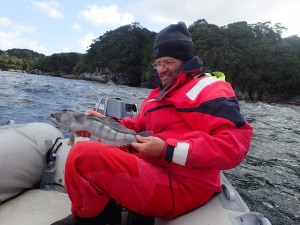 On one such fishing trek we punctured a hole on the dinghy floor. Not sure if this was done by the sharp Blue Cod fins or the knife I left on the floor after chopping up squid bait. We limped home with the air escaping out of our previous leak and now the dinghy floor was slowly collapsing. That evening, a tour boat named Pembroke came into the cove and they opted not to raft up to us but asked if we needed anything. I did mention our need for contact cement to fix our dinghy leaks and a couple of hours later they showed up with everything one would need to fix the leaks and a great bottle of white wine with a beautiful, delicious crayfish. Now that is Fiordland hospitality!!
On one such fishing trek we punctured a hole on the dinghy floor. Not sure if this was done by the sharp Blue Cod fins or the knife I left on the floor after chopping up squid bait. We limped home with the air escaping out of our previous leak and now the dinghy floor was slowly collapsing. That evening, a tour boat named Pembroke came into the cove and they opted not to raft up to us but asked if we needed anything. I did mention our need for contact cement to fix our dinghy leaks and a couple of hours later they showed up with everything one would need to fix the leaks and a great bottle of white wine with a beautiful, delicious crayfish. Now that is Fiordland hospitality!!
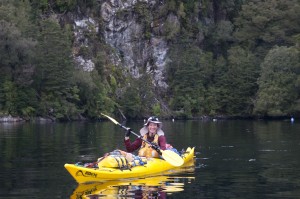 As we were getting ready to leave Luncheon cove and to make our way to the next fiord we met a Henrietta or Henry, as she called herself, the kayaker. She was slowly kayaking her way up the fiords. All she had was her kayak well packed with her sleeping gear, tent, maps, compass, helmet, food and any other gear she thought she would need for the months it would take her to make her way North through the fiords. We admired her spirit and courage!
As we were getting ready to leave Luncheon cove and to make our way to the next fiord we met a Henrietta or Henry, as she called herself, the kayaker. She was slowly kayaking her way up the fiords. All she had was her kayak well packed with her sleeping gear, tent, maps, compass, helmet, food and any other gear she thought she would need for the months it would take her to make her way North through the fiords. We admired her spirit and courage!
Click here for Google Map Link – Cascade Cove
Our attempt to leave Dusky was thwarted by a continuously increasing wind on the nose so we decided to turn back to Dusky and anchor in Cascade Cove. There was another sailboat there and they invited us to raft up to them. It was a red steel boat from Germany, Muktuk. I did a quick Kayak trip to the end of the bay while Denny picked a pail full of mussels for supper. Henry was also kayaking there so I invited her to spend a night on Landfall and have dinner with us. Birgit and Andreas from Muktuk had also asked us to come over for coffee and we brought Henry along who incidentally is also German although now lives in NZ. Muktuk have a nice little wood stove on their steel boat so it was cozy and warm while we enjoyed great coffee, freshly baked muffins and entertaining conversations. Birgit and Andreas later came on board Landfall and brought with them a wood smoked Blue Cod. Andreas had built a smoker that he attached to the end of their wood burning stove pipe. What a treat that was!! It has inspired Denny to maybe try smoking meat when we get back to our South Dakota cabin. Next morning we said good bye to our new German friends and Birgit gave us a freshly baked sour dough bread for our trip to the next fiord or to Steward Island, depending which way the wind wanted to take us.
